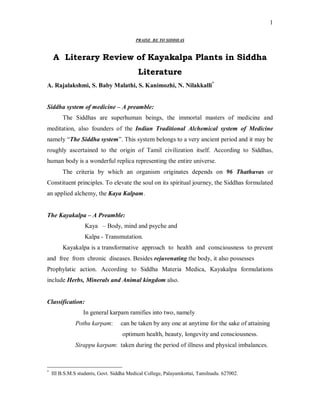
Kaya kalpa planten
- 1. 1 PRAISE BE TO SIDDHAS A Literary Review of Kayakalpa Plants in Siddha Literature A. Rajalakshmi, S. Baby Malathi, S. Kanimozhi, N. Nilakkalli* Siddha system of medicine – A preamble: The Siddhas are superhuman beings, the immortal masters of medicine and meditation, also founders of the Indian Traditional Alchemical system of Medicine namely “The Siddha system”. This system belongs to a very ancient period and it may be roughly ascertained to the origin of Tamil civilization itself. According to Siddhas, human body is a wonderful replica representing the entire universe. The criteria by which an organism originates depends on 96 Thathuvas or Constituent principles. To elevate the soul on its spiritual journey, the Siddhas formulated an applied alchemy, the Kaya Kalpam. The Kayakalpa – A Preamble: Kaya – Body, mind and psyche and Kalpa - Transmutation. Kayakalpa is a transformative approach to health and consciousness to prevent and free from chronic diseases. Besides rejuvenating the body, it also possesses Prophylatic action. According to Siddha Materia Medica, Kayakalpa formulations include Herbs, Minerals and Animal kingdom also. Classification: In general karpam ramifies into two, namely Pothu karpam: can be taken by any one at anytime for the sake of attaining optimum health, beauty, longevity and consciousness. Sirappu karpam: taken during the period of illness and physical imbalances. * III B.S.M.S students, Govt. Siddha Medical College, Palayamkottai, Tamilnadu. 627002.
- 2. 2 Kayakalpa Plants: In the text “Karuvoorar Vadha Kaaviyam” it has been mentioned that nearly 108 Herbs are termed as Karpa Mooligaigal. Pothu karpam comprises of plants such as • Zingiber officinale (ginger), • Alternanthera sessilis (sessile leaf), • Azadirachta indica (neem), • Aloe barbadensis (aloe), • Withania somnifera (winter cherry) etc., Sirappu karpam comprises of plants such as • Phyllanthus amarus (Indian phyllanthus), • Semecarpus anacardium (marking nut), • Phyllanthus emblica (Indian gooseberry), • Ocimum sanctum (sacred basil), • Acalypha indica (cat’s struggle) etc., Time of Consumption: Predominantly, Morning is stated as the optimum time for consumption of Karpam, whereas evening is also preferred for some preparations. For example, Kadukkai (chebulic myrobalan) is preferred during evening. Initiative measures on Consumption: Before consuming Kayakalpam, primarily the body has to be prepared. It is to be noted that consumption of kayakalpa along with some simple Yogasanas makes the purpose fruitful.
- 3. 3 Compatible Diet: According to Siddha literature, Food itself is a Medicine. Food in our diet either enhances or disturbs the potency of the drug consumed. In accordance with that some of the compatible diets are as follows. Solanum trilobatum, dried fruit of Solanum nigrum, dried fruit of chundai, Alternanthera sessilis, leaves of black neem, red gram, black pepper, Cumin, Clove, bark of Cinnamom , fruits or seeds of Cardamom, Myristica fragrans, cane sugar, cow’s milk, ghee, mango, Indian gooseberry etc., The above mentioned items are general and there are separate list of varieties which can be added for each and every karpam. The references are given in the text of Pathiya Vithi Pathiyam and Pathiya Nirnayam.. These are listed on the basis of the “Arusuvaigal”, the main criteria namely Sweet, Salt, Sour, Astringent, Pungent, Bitter which was primarily based on the Pancha Bhuthic Theory. Pathiyam: This refers the sort of food to be neglected. Salt, Tamarind, Mustard, Ginger, Flesh, Fish, Ash pumpkin, Horse gram, Tobacco, Betel should be prohibited. Sexual abstinence is also advised. This is for the purpose of Rejuvenation instead of Generation which is very much needed. Each drug has its own diet restrictions. The sort of diet to be restricted or added depends on various factors such as patients physic, pathognomonic conditions, potency of medicine, period of drug consumption, environmental changes etc., Uncertainty could be compensated with the guidance of experienced physicians to select the diet. Age Group: There are certain age limitations. Kayakalpa hardly produces any remarkable effect beyond Fifth decade of life due to degenerative changes in the body.
- 4. 4 Specialities of Kayakalpa: Kayakalpa does not mean restoring old to youth, it means the maintenance of youth without mere lethargy both physically and mentally. Kayakalpa prevents and brings us to a state that the body could not only be healthy but also fulfills the purpose of being healthy, becoming a person meaningful and very much in Harmony with the nature. Discussion: Till now the Siddha medicines are being used for various ailments for both physiological and psychological wellbeing. Though these are in written forms by Siddhas, this system stands neglected and identified wrongly as unscientific and superstitious. In addition a systematic analysis of these drugs based on recent scientific methodology is also lacking, even though Multifarious actions have been indicated in Siddha literature. Scientific investigations should be done to confirm the Siddha claims to achieve the Siddha Goal (i.e.) to free Humanity from Diseases. Conclusion: With the help of kayakalpa the innate Rejuvenating powers of body are awakened thus creating a magnetic and vital being. It helps us to live our life to the fullest at the same time to understand what life is all about. This is only a curtain raiser and a further evaluation has to be done with this work. References: 1. ‘History of Siddha medicine’ Ist edition, 1979 by Mr. N. Kandasamy Pillai, Siddha science development committee, Govt. of Tamilnadu. 2. ‘Heritage of Tamils’ Ist edition, March 1983 by Dr. S.V. Subramanian, V.R. Madhavan, International Institute of Tamil Studies, Chennai, 113.
- 5. 5 3. ‘Sattaimuni Gnanam’, Ist edition December 2001 by Mr. S.P. Ramachandran, Thamarai Noolagam, Chennai. 4. Dictionary of Medicine, Chemistry, Botany and Allied sciences (Based on Indian medical science), volume II, IInd edition, 1992. By T.V. Sambasivam Pillai, published by Department of Indian Medicine and Homeopathy, Chennai – 106. 5. ‘Siddha Maruthuvam Sirappu’ by Dr. R. by Dr. R. Thiagarajan, IInd edition, 1995, Published by The Directorate of Indian Medicine & Homeopathy, Chennai, India.
